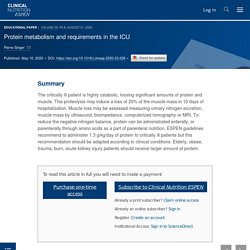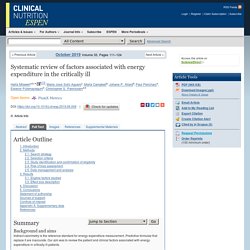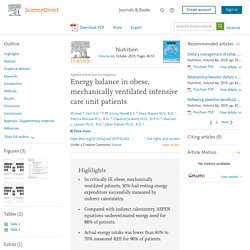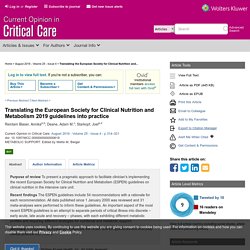

Micronutrient status during paediatric critical illness: A scoping review - Clinical Nutrition. World Health O.

Micronutrients Geneva, Switzerland. World Health Organisation, 2019 ()CfDCa Prevention Micronutrients Washington DC. Clinical Sequelae From Overfeeding in Enterally Fed Critically Ill Adults: Where Is the Evidence? - Chapple - 2020 - Journal of Parenteral and Enteral Nutrition. Introduction Overfeeding, the provision of energy in excess of metabolic requirements to critically ill patients, is thought to be associated with adverse clinical sequelae, including hyperglycemia, liver dysfunction, increased risk of infection, prolonged weaning from ventilatory support, and increased mortality.1 However, despite reported concerns, there is no universally agreed‐upon definition as to what constitutes energy overfeeding or the clinical consequences.

Moreover, the literature on overfeeding has predominantly been limited to energy delivery via the parenteral, rather than enteral, route.2 In contrast to parenterally delivered nutrients, innate enteral control mechanisms may prevent or reduce the risk of overfeeding in the critically ill. Protein metabolism and requirements in the ICU - Clinical Nutrition ESPEN. Attaix D.

Boirie Y. Metaboisme protidique.in: Hebuterne X. Traite de Nutrition articifielle de l'adulte. Springer, Paris2007: 75-92Weijs P.J.M. How to choose the best route of feeding during critical illness - Clinical Nutrition ESPEN. Seven Deadly Sins of Nutrition Therapy in Critically Ill Patients - Loss - 2020 - Nutrition in Clinical Practice. Nutrition in Sepsis: A Bench-to-Bedside Review. Nutrition therapy in sepsis is challenging and differs from the standard feeding approach in critically ill patients.

The dysregulated host response caused by infection induces progressive physiologic alterations, which may limit metabolic capacity by impairing mitochondrial function. Hence, early artificial nutrition should be ramped-up and emphasis laid on the post-acute phase of critical illness. Caloric dosing is ideally guided by indirect calorimetry, and endogenous energy production should be considered. Proteins should initially be delivered at low volume and progressively increased to 1.3 g/kg/day following shock symptoms wane.
Nutritional support in sepsis: when less may be more. Inflammatory mediators are potent inducers of catabolism.

Indeed, cytokines have a well-appreciated role in inducing the breakdown of proteins in muscle, promoting bone resorption and also driving lipolysis in adipocytes [19]. In turn, the catabolic state also drives what has until recently been described as a manifestation of “metabolic derangements” such as the hyperglycaemia invariably observed in critical care patients. However, there is evidence to suggest that catabolism is more than just a means to an end (i.e. the liberation of metabolic substrate) but is in itself a survival strategy.
Macro-autophagy (hereafter simply autophagy) is an evolutionarily conserved catabolic process that plays an essential role in promoting cell survival [20]. Conceptually, the autophagic process consists of two major steps. Nutritional support for children during critical illness: European Society of Pediatric and Neonatal Intensive Care (ESPNIC) metabolism, endocrine and nutrition section position statement and clinical recommendations. Nutrition therapy in critical illness: a review of the literature for clinicians. Nutrition therapy and critical illness: practical guidance for the ICU, post-ICU, and long-term convalescence phases. Effect of Registered Dietitian Nutritionist Order‐Writing Privileges on Enteral Nutrition Administration in Selected Intensive Care Units - Arney - 2019 - Nutrition in Clinical Practice.
Background Adequate nutrition is linked to improved patient outcomes during critical illness.

Nutrition care is further enhanced by registered dietitian nutritionist (RDN) order‐writing privileges, which improve the implementation of nutrition interventions. The purpose of this performance improvement project was to evaluate the effect of RDN order‐writing privileges on enteral nutrition (EN) order compliance and nutrition delivery in selected intensive care units (ICUs) at a university‐affiliated teaching hospital. Methods Patients admitted to selected ICUs from January 23, 2018, to January 25, 2018, were screened for eligibility. Results. Post-extubation dysphagia: a problem needing multidisciplinary efforts. Refeeding Syndrome in the Critically Ill: a Literature Review and Clinician’s Guide. Clinical Nutrition in Critical Care Medicine – Guideline of the German Society for Nutritional Medicine (DGEM) - Clinical Nutrition ESPEN. Systematic review of factors associated with energy expenditure in the critically ill - Clinical Nutrition ESPEN.
Second, this study identified groups of factors that were significant in different patient populations.

Factors representing size, inflammatory state, and caloric intake were positively associated with EE in studies of adults, children, and neonates. Representations of these factors should be included in additional studies of EE in critically ill patients to determine the specific factor within these categories that are associated with EE, the optimal factor representation, and the types of interactions between these different factors and how it affects the relationship with EE. Energy balance in obese, mechanically ventilated intensive care unit patients. C.J.

Klein, G.S. Stanek, C.E. Wiles 3rdOverfeeding macronutrients to critically ill adults: metabolic complications J Am Diet Assoc, 98 (1998), pp. 795-806 R.D. Crit Care, 11 (2007), p. 176 J.C. Crit Care, 19 (2015), p. 35 E.M. Curr Opin Crit Care, 11 (2005), pp. 300-303 C.W. Intensive Care Med, 35 (2009), pp. 1152-1170. Metabolic support in the critically ill: a consensus of 19.
During the last decade, understanding of critical illness-related metabolic changes has evolved following advances based on novel discoveries and clinical evidence from prospective randomized controlled trials (RCTs).

In this review, we discuss the influence of these recent findings on the daily care of critically ill patients, focusing on nutrition as a cornerstone of metabolic care. Integrating clinical trial data into individual patient care is complex, so we have tried to group issues together into discrete, clinically relevant questions, but acknowledge that some aspects will inevitably fall into more than one category. Question 1: Should outcomes in clinical trials on metabolic care be more patient-centered? Medical progress has enabled effective treatment of older and frail patients with higher severity of disease than in the past. Question 2: Have we characterized the underlying biochemistry sufficiently? Translating the European Society for Clinical Nutrition and... : Current Opinion in Critical Care. To present a pragmatic approach to facilitate clinician's implementing the recent European Society for Clinical Nutrition and Metabolism (ESPEN) guidelines on clinical nutrition in the intensive care unit.

The ESPEN guidelines include 54 recommendations with a rationale for each recommendation. All data published since 1 January 2000 was reviewed and 31 meta-analyses were performed to inform these guidelines. An important aspect of the most recent ESPEN guidelines is an attempt to separate periods of critical illness into discrete – early acute, late acute and recovery – phases, with each exhibiting different metabolic profiles and requiring different strategies for nutritional and metabolic support. A pragmatic approach to incorporate the recent ESPEN guidelines into everyday clinical practice is provided. NUTRITION IN CRITICALLY ILL PATIENTS supplement. Enteral Nutrition in the Mechanically Ventilated Patient - Allen - 2019 - Nutrition in Clinical Practice. Obesity in the critically ill: a narrative review. Strategies for optimal calorie administration in critically ill patients. IC is the only practical clinical method for EE measurement and is considered as the gold standard [5, 17].
As described above, this technique measures VO2 and VCO2 for calculating EE using the Weir equation. Contrastingly, the HBE, one of the popular predictive equations, estimates EE using four simple factors, namely, gender, age, height, and weight [18]: Probiotic and synbiotic therapy in the critically ill: State of the art. JavaScript is disabled on your browser.
Please enable JavaScript to use all the features on this page. Highlights Commensal microorganisms play vital roles in human physiology in nutrition, vitamin synthesis, drug metabolism, protection against infection, and recovery from illness. Current evidence on ω-3 fatty acids in enteral nutrition in the critically ill: A systematic review and meta-analysis. Fish oil exerts anti-inflammatory and immunomodulatory properties that may be beneficial for critically ill patients, thus multiple randomized controlled trials and meta-analyses have been performed. However, controversy remains as to whether fish oil–enriched enteral nutrition can improve clinical outcomes in adult critically ill patients in intensive care units (ICUs). The aim of this study was to provide an up-to-date systematic review and meta-analysis of all randomized controlled trials of fish oil–containing enteral nutrition addressing relevant clinical outcomes in critically ill patients.
A systematic literature search was conducted. The primary outcome was 28-d mortality. Secondary outcomes were ICU and hospital mortality, ICU and hospital length of stay (LOS), ventilation duration, and infectious complications. Parenteral nutrition in the ICU: Lessons learned over the past few years. JavaScript is disabled on your browser. Please enable JavaScript to use all the features on this page. Highlights Critically ill patients start their acute journey in very different conditions determined by age, previous nutritional status, and severity of acute insult. The body is able to generate an important endogenous glucose production in the early phase at the expense of protein catabolism for gluconeogenesis.
Metabolic support challenges with obesity during critical illness. J Upadhyay, O Farr, N Perakakis, W Ghaly, C MantzorosObesity as a disease Med Clin North Am, 102 (2018), pp. 13-33 BA Swinburn, G Sacks, KD Hall, K McPherson, DT Finegood, ML Moodie, et al.The global obesity pandemic: Shaped by global drivers and local environments Lancet, 378 (2011), pp. 804-814. Methods of Enteral Nutrition Administration in Critically Ill Patients: Continuous, Cyclic, Intermittent, and Bolus Feeding - Ichimaru - 2018 - Nutrition in Clinical Practice. ESPEN guideline on clinical nutrition in the intensive care unit - Clinical Nutrition. Autophagy and Its Implications Against Early Full Nutrition Support in Critical Illness - Dyck - - Nutrition in Clinical Practice. Monitoring Nutrition in Critical Illness: What Can We Use? - Ferrie - 2018 - Nutrition in Clinical Practice. Is refeeding syndrome relevant for critically ill patients? : Current Opinion in Clinical Nutrition & Metabolic Care.
Lipids in the intensive care unit: Recommendations from the ESPEN Expert Group. Early or Late Feeding after ICU Admission? 1. Introduction Over the last decades, nutritional interventions carried out in critically ill patients were characterized by different timings, strategies, and terminologies. Recent randomised trials have brought some new insights in this topic, challenging several earlier beliefs. Early full nutrition—which is achieved more easily with parenteral nutrition (PN)—is associated with negative clinical outcomes, whereas the route itself may be irrelevant [1]. In the case of enteral nutrition (EN), full feeding may actually invalidate its beneficial effects, as shown by two randomised trials—the CALORIES trial [2] and the recent EAT-ICU trial [3]. After clarifying some important definitions (Table 1), the aim of this narrative review is to summarize the physiological and clinical evidence regarding the consequences of early vs. late feeding, and give suggestions on how to transfer this knowledge to practice.
Table 1. 2. Figure 1. 3. 4. 5. Guidelines for the Provision and Assessment of Nutrition Support Therapy in the Pediatric Critically Ill Patient: Society of Critical Care Medicine and American Society for Parenteral and Enteral Nutrition. Nutrition Support for Critically Ill Patients With Cancer. Publications - Critical Care Nutrition. Guidelines for the Provision and Assessment of Nutrition Support Therapy in the Adult Critically Ill Patient. Optimal nutrition therapy in paediatric critical care in the Asia-Pacific and Middle East: a consensus.
Early enteral nutrition in critically ill patients: ESICM clinical practice guidelines. Question 11:Should we delay EN in patients with severe acute pancreatitis (SAP)? We identified five systematic reviews with meta-analyses comparing EN to PN while not considering timing (Supplement 5, Table 11B). All meta-analyses concluded that EN was beneficial in reducing infections and three reported reduced mortality [3, 34, 35]. We identified five RCTs addressing EEN (“early” as defined by the authors) vs. early PN in SAP whereas only two studies defined “early” as <48 h. Three further RCTs addressed EEN vs. early PN and one RCT EEN vs. delayed EN in “predicted SAP”.
Two RCTs addressing acute pancreatitis independent of severity and one RCT studying mixed patients undergoing abdominal surgery were not included. We performed three separate meta-analyses all comparing EEN vs. early PN: (A) SAP and “early” as defined by the authors of the original study; (B) predicted SAP and “early” as defined by the authors of the original study; (C) predicted SAP and early defined as <48 h. Pragmatic approach to nutrition in the ICU: Expert opinion regarding which calorie protein target. Body glycogen energy reserves decrease substantially after 24 h of fasting.2 In addition, fasting over three days in healthy persons induces insulin resistance.
Nutrition therapy in critically ill patients- a review of current evidence for clinicians. Relevance of non-nutritional calories in mechanically ventilated critically ill patients. Probiotic and synbiotic therapy in critical illness: a systematic review and meta-analysis.